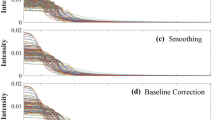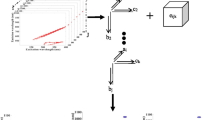Abstract
Petroleum products are the target of fraudulent practices due to their high commercial value. The aim of this study is to provide a new analysis system to assess motor oil adulteration. For this purpose, Laser Induced Fluorescence (LIF) spectroscopy was exploited coupled with chemometric tools to detect motor oil adulteration by three types of cheap motor oils. Principal Component Analysis (PCA) was able to distinguish samples in three groups according to the type of adulterant. Besides, Partial Least Squares Regression (PLSR) was exploited to determine the percentage of adulteration. The best model was obtained with a regression coefficient of 0.96, Root Mean Square Error of Prediction (RMSEP) of 2.83, Standard Error of Prediction (SEP) of 2.83 and Bias of 0.40. The main results of this work provide new analysis system using the combination of LIF spectroscopy combined to PCA and PLS as an efficient and fast method for motor oil analysis.








Similar content being viewed by others
Data Availability
The data that support the findings of this study are available on request from the corresponding author.
References
Mishra A, Kumari U, Yasaswy V et al (2020) Extensive thermogravimetric and thermo-kinetic study of waste motor oil based on iso -conversional methods. Energy Convers Manag 221:113–194. https://doi.org/10.1016/j.enconman.2020.113194
Balabin RM, Safieva RZ, Lomakina EI (2011) Near-infrared (NIR) spectroscopy for motor oil classification: From discriminant analysis to support vector machines. Microchem J 98:121–128. https://doi.org/10.1016/j.microc.2010.12.007
Ahmadi S, Mani-varnosfaderani A, Habibi B (2018) Motor oil classification using color histograms and pattern recognition techniques. J AOAC Int 101:1967–1975. https://doi.org/10.5740/jaoacint.17-0308
Yang C, Yang Z, Zhang G et al (2016) Characterization and differentiation of chemical fingerprints of virgin and used lubricating oils for identification of contamination or adulteration sources. Fuel 163:271–281. https://doi.org/10.1016/j.fuel.2015.09.070
Al-Ghouti MA, Al-Degs YS, Amer M (2008) Determination of motor gasoline adulteration using FTIR spectroscopy and multivariate calibration. Talanta 76:1105–1112. https://doi.org/10.1016/j.talanta.2008.05.024
Hooftman N, Messagie M, Van Mierlo J, Coosemans T (2018) A review of the european passenger car regulations – real driving emissions vs local air quality. Renew Sustain Energy Rev 86:1–21. https://doi.org/10.1016/j.rser.2018.01.012
Lack DA, Cappa CD, Langridge J et al (2011) Impact of fuel quality regulation and speed reductions on ship** emissions: implications for climate and air quality. Environ Sci Technol 45:9052–9060. https://doi.org/10.1021/es2013424
Shimamoto GG, Tubino M (2016) Alternative methods to quantify biodiesel in standard diesel-biodiesel blends and samples adulterated with vegetable oil through UV–Visible spectroscopy. Fuel 186:199–203. https://doi.org/10.1016/j.fuel.2016.08.076
Bassbasi M, Hafid A, Platikanov S et al (2013) Study of motor oil adulteration by infrared spectroscopy and chemometrics methods. Fuel 104:798–804. https://doi.org/10.1016/j.fuel.2012.05.058
Prasad B, Kumar J, Ray A et al (2020) Determination of biodiesel and used cooking oil in automotive diesel / green diesel fuels through high-performance liquid chromatography. J Chromatogr A 1629:1–12. https://doi.org/10.1016/j.chroma.2020.461512
Mao D, Van De WH, Lookman R et al (2009) Resolving the unresolved complex mixture in motor oils using high-performance liquid chromatography followed by comprehensive two-dimensional gas chromatography. Fuel 88:312–318. https://doi.org/10.1016/j.fuel.2008.08.021
Desai N, Nagaraj AM, Sabnis N (2021) Analysis of thermo-physical properties of SAE20W40 engine oil by the addition of SiO2 nanoparticles. Mater Today Proc 47:5646–5651. https://doi.org/10.1016/j.matpr.2021.03.688
Kanyathare B, Asamoah BO, Ishaq U et al (2020) Optical transmission spectra study in visible and near-infrared spectral range for identification of rough transparent plastics in aquatic environments. Chemosphere (248):1–9. https://doi.org/10.1016/j.chemosphere.2020.126071
Kanyathare B, Asamoah B, Peiponen KE (2019) Imaginary optical constants in near-infrared (NIR) spectral range for the separation and discrimination of adulterated diesel oil binary mixtures. Opt Rev 26:85–94. https://doi.org/10.1007/s10043-018-0481-9
Najib M, Botosoa EP, Hallab W et al (2020) Utilization of front-face fluorescence spectroscopy for monitoring lipid oxidation during Lebanese Qishta aging. Lwt 130:109–693. https://doi.org/10.1016/j.lwt.2020.109693
Galvin-King P, Haughey SA, Elliott CT (2021) Garlic adulteration detection using NIR and FTIR spectroscopy and chemometrics. J Food Compos Anal 96:103–757. https://doi.org/10.1016/j.jfca.2020.103757
Kamal M, Karoui R (2017) Monitoring of mild heat treatment of camel milk by front-face fl uorescence spectroscopy. LWT - Food Sci Technol 79:586–593. https://doi.org/10.1016/j.lwt.2016.11.013
Wu X, Zhao Z, Tian R et al (2021) Total synchronous fluorescence spectroscopy coupled with deep learning to rapidly identify the authenticity of sesame oil. Spectrochim Acta Part A Mol Biomol Spectrosc 244:1–9. https://doi.org/10.1016/j.saa.2020.118841
Addou S, Fethi F, Chikri M, Rrhioua A (2016) Detection of argan oil adulteration with olive oil using fluorescence spectroscopy and chemometrics tools. JMES 7:2689–2698
Mei L, Lundin P, Brydegaard M et al (2012) Tea classification and quality assessment using laser-induced fluorescence and chemometric evaluation. Appl Opt 51:803–811. https://doi.org/10.1364/AO.51.000803
Ao SHH, Hu LIANZ, Ui ROS et al (2019) Identification and quantification of vegetable oil adulteration with waste frying oil by laser-induced fluorescence spectroscopy. OSA Contin 2:1148–1154
Wold JP, Bro R, Veberg A et al (2006) Active photosensitizes in butter detected by fluorescence spectroscopy and multivariate curve resolution. J Agric Food Chem 54:10197–10204. https://doi.org/10.1021/jf0621166
Razvi MAN, Bakry A, Saeed A, Mohammad AS (2020) Diagnosis of oral squamous cell carcinoma (OSCC) using laser induced fluorescence. Sci Adv Mater 12:853–860. https://doi.org/10.1166/sam.2020.3759
Hashemi P, Erim FB (2016) Analysis of vitamin B2 in saffron stigmas ( Crocus sativus L ) by capillary electrophoresis coupled with laser-induced fluorescence detector. Food Anal Methods 95:1–5. https://doi.org/10.1007/s12161-016-0430-9
Poozesh M, Ghasemzadeh H, Ablollahpour S (2020) Effect of DL-Methionine concentration, moisture content and bulk density of Animal feed on the light-induced fluorescence as a process analytical tool. Sci Technol 28:33–48
Chullipalliyalil K, Lewis L, McAuliffe MAP (2020) Deep UV laser-Induced fluorescence for pharmaceutical cleaning validation. Anal Chem 92:1447–1454. https://doi.org/10.1021/acs.analchem.9b04658
Vempatapu BP, Kanaujia PK (2017) Monitoring petroleum fuel adulteration : A review of analytical methods. Trends Anal Chem 92:1–11. https://doi.org/10.1016/j.trac.2017.04.011
Marzouk AAEH (2015) Characterization of petroleum crude oils using laser induced fluorescence. J Pet Environ Biotechnol 06:1–8. https://doi.org/10.4172/2157-7463.1000240
Raimondi V, Cecchi G, Pantani L, Chiari R (1998) Fluorescence lidar monitoring of historic buildings. Appl Opt 37:1089–1098
Svanberg S (1995) Fluorescence lidar monitoring of vegetation status. Phys Scr 58:79–85
Chikri M, Fethi F, Hamdani I et al (2018) Discrimination of chemical compounds of the oil of Menthasuaveolens ( L.) of Eastern Morocco by the GPC-MS and chemometric methods. J Mater Environ Sci 9:909–917
Zhu C, Tang Z, Li Q et al (2020) Lead of detection in rhododendron leaves using laser-induced breakdown spectroscopy assisted by laser-induced fluorescence. Sci Total Environ 20:139402. https://doi.org/10.1016/j.scitotenv.2020.139402
Saleem M, Atta BM, Ali Z, Bilal M (2020) Laser-induced fluorescence spectroscopy for early disease detection in grapefruit plants. Photochem Photobiol Sci 19:713–721. https://doi.org/10.1039/c9pp00368a
Meng F, Chen S, Zhang Y et al (2015) Characterization of motor oil by laser-induced fluorescence. Anal Lett 48:2090–2095. https://doi.org/10.1080/00032719.2015.1015073
Yang J, Yin C, Miao X et al (2020) Rapid discrimination of adulteration in radix astragali combining diffuse reflectance mid-infrared fourier transform spectroscopy with chemometrics. Spectrochim acta part A Mol Biomol Spectrosc 75:1–25. https://doi.org/10.1016/j.saa.2020.119251
Du Q, Zhu M, Shi T et al (2021) Adulteration detection of corn oil, rapeseed oil and sunflower oil in camellia oil by in situ diffuse reflectance near-infrared spectroscopy and chemometrics. Food Control 121:1–9. https://doi.org/10.1016/j.foodcont.2020.107577
Kucharska-ambrożej K, Karpinska J (2020) The application of spectroscopic techniques in combination with chemometrics for detection adulteration of some herbs and spices. Microchem J 153:1–9. https://doi.org/10.1016/j.microc.2019.104278
Campmajó G, Saez-vigo R, Saurina J, Núñez O (2020) High-performance liquid chromatography with fluorescence detection fingerprinting combined with chemometrics for nut classification and the detection and quantitation of almond-based product adulterations. Food Control 114:1–6. https://doi.org/10.1016/j.foodcont.2020.107265
Farres S, Srata L, Fethi F, Kadaoui A (2019) Vibrational spectroscopy argan oil authentication using visible / near infrared spectroscopy combined to chemometrics tools. Vib Spectrosc 102:79–84. https://doi.org/10.1016/j.vibspec.2019.04.003
Liu Y, Liu Y, Chen Y et al (2019) The influence of spectral pretreatment on the selection of representative calibration samples for soil organic matter estimation using Vis-NIR reflectance spectroscopy. Remote Sens 11:1–16. https://doi.org/10.3390/rs11040450
de Macêdo IYL, Machado FB, Ramos GS et al (2021) Starch adulteration in turmeric samples through multivariate analysis with infrared spectroscopy. Food Chem 340:127–899. https://doi.org/10.1016/j.foodchem.2020.127899
Mahmoudi MR, Heydari MH, Qasem SN et al (2021) Principal component analysis to study the relations between the spread rates of covid-19 in high risks countries. Alexandria Eng J 60:457–464. https://doi.org/10.1016/j.aej.2020.09.013
Udompetaikul V, Phetpan K, Sirisomboon P (2021) Development of the partial least-squares model to determine the soluble solids content of sugarcane billets on an elevator conveyor. Measurement 167:1–9. https://doi.org/10.1016/j.measurement.2020.107898
Li S, Ng T, Yao Z (2021) Quantitative analysis of blended oils by matrix-assisted laser desorption / ionization mass spectrometry and partial least squares regression. Food Chem 334:1–9. https://doi.org/10.1016/j.foodchem.2020.127601
Srata L, Farres S, Fethi F (2019) Engine oil authentication using near infrared spectroscopy and chemometrics methods. Vib Spectrosc 100:99–106. https://doi.org/10.1016/j.vibspec.2018.10.002
Author information
Authors and Affiliations
Contributions
Data available from the authors upon reasonable request.
Corresponding author
Ethics declarations
Ethics of Approval
Not related.
Consent to Participate
Not related.
Consent for Publication
Not related.
Conflicts of Interest/Competing Interests (Include Appropriate Disclosures)
The authors declare they have no competing interests.
Additional information
Publisher's Note
Springer Nature remains neutral with regard to jurisdictional claims in published maps and institutional affiliations.
Rights and permissions
Springer Nature or its licensor (e.g. a society or other partner) holds exclusive rights to this article under a publishing agreement with the author(s) or other rightsholder(s); author self-archiving of the accepted manuscript version of this article is solely governed by the terms of such publishing agreement and applicable law.
About this article
Cite this article
Srata, L., Farres, S., Chikri, M. et al. Detection of the Adulteration of Motor Oil by Laser Induced Fluorescence Spectroscopy and Chemometric Techniques. J Fluoresc 33, 713–720 (2023). https://doi.org/10.1007/s10895-022-03108-9
Received:
Accepted:
Published:
Issue Date:
DOI: https://doi.org/10.1007/s10895-022-03108-9




